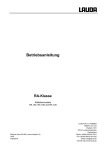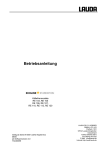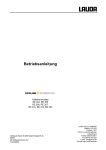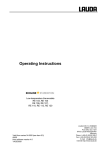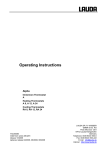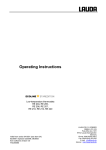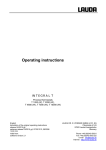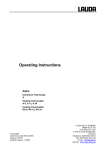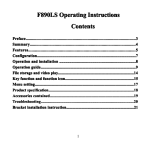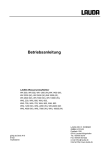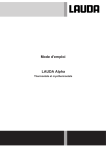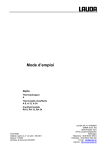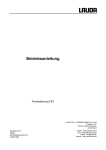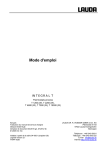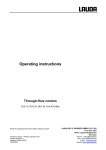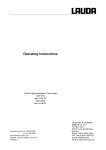Download Operating Instructions Class RA
Transcript
Operating Instructions Class RA Cooling thermostats RA 104, RA 106 and RA 120 Valid from series 05-0001 (see item 8.3) 10/05 YAEE0018 LAUDA DR. R. WOBSER GMBH & CO. KG Post office box 1251 97912 Lauda-Koenigshofen Germany Phone: 0049 (0)9343/ 503-0 Fax: 0049 (0)9343/ 503-222 E-mail: [email protected] Internet http://www.lauda.de Class RA Safety notes Before operating the equipment please read carefully all the instructions and safety notes. If you have any questions please phone us! Follow the instructions on setting up, operation etc. This is the only way to avoid incorrect operation of the equipment and to ensure full warranty protection. • Transport the equipment with care! The unit may NEVER be overturned nor put upside down! • Equipment and its internal parts can be damaged: − by dropping − by shock. • Equipment must only be operated by technically qualified personnel! • Never operate the equipment without the bath liquid! • Do not start up the equipment, if − it is damaged or leaking, − the supply cable is damaged. • Switch off the equipment and pull out the mains plug: − for servicing or repair − before moving the equipment! • Drain the bath before moving the equipment! • Do not carry out any technical changes on the device! • Have the equipment serviced or repaired by properly qualified personnel only! The Operating Instructions include additional safety notes which are identified by a triangle with an exclamation mark. Carefully read the instructions and follow them accurately! Disregarding the instructions may have serious consequences, such as damage to the equipment, damage to property or injury to personnel! We reserve the right to make technical alterations! YAEE0018 / 07.03.2006 Safety notes 3 Class RA TABLE OF CONTENTS Safety notes ....................................................................................................................................3 1 SAFETY NOTES...........................................................................................................................6 1.1 General safety notes ............................................................................................................6 1.2 Other safety notes ................................................................................................................6 2 BRIEF OPERATING INSTRUCTIONS .........................................................................................8 3 CONTROL AND FUNCTIONAL ELEMENTS ...............................................................................9 4 UNIT DESCRIPTION ..................................................................................................................10 4.1 Environmental conditions..................................................................................................10 4.2 Unit types ............................................................................................................................10 4.3 Baths....................................................................................................................................10 4.4 Pump....................................................................................................................................10 4.5 Materials ..............................................................................................................................11 4.6 Temperature indication, control and safety circuit .........................................................11 4.7 Refrigeration system ..........................................................................................................11 5 UNPACKING...............................................................................................................................12 6 PREPARATIONS........................................................................................................................13 7 8 6.1 Assembly and setting up ...................................................................................................13 6.2 Filling and emptying...........................................................................................................14 6.3 Bath liquids and hose connections ..................................................................................16 6.4 Connection of external circuits .........................................................................................17 STARTING UP ............................................................................................................................18 7.1 Connection to the supply...................................................................................................18 7.2 Switching on .......................................................................................................................18 7.3 Set point selection..............................................................................................................19 7.4 Warning and safety functions ...........................................................................................19 7.4.1 Overtemperature protection and testing ..................................................................................19 7.4.2 Low-level protection ...................................................................................................................20 7.4.3 Pump motor monitoring .............................................................................................................21 MAINTENANCE..........................................................................................................................22 8.1 4 Cleaning...............................................................................................................................22 Table of contents 07.03.2006 / YAEE0018 Class RA 8.2 Maintenance and repair..................................................................................................... 22 8.2.1 Maintenance of the refrigeration unit .......................................................................................23 8.2.2 Note on repair and disposal ......................................................................................................23 Repair and disposal by a qualified refrigeration engineer only! ..............................................................23 8.3 9 10 Ordering spares ................................................................................................................. 24 TECHNICAL DATA (ACCORDING TO DIN 12876) ...................................................................... 25 ACCESSORIES ...................................................................................................................... 27 YAEE0018 / 07.03.2006 Table of contents 5 Class RA 1 Safety notes 1.1 General safety notes A laboratory thermostat is intended for heating and pumping liquids according to the needs of the user. This leads to hazards by high temperatures, fire, and the general hazards by the use of electrical energy. The user is largely protected through the application of the appropriate standard specifications. Additional hazards may arise from the type of material being thermostated, e.g. when going above or below certain temperature levels or through breaking of the container and reaction with the thermostating liquid. It is not possible to cover all possibilities; they remain largely within the responsibility and the judgement of the user. The unit must only be used as intended and as described in these Operating Instructions. This includes operation by suitably instructed qualified personnel. The units are not designed for use under medical conditions according to EN 60601-1 or IEC 601-1 ! 1.2 Other safety notes • Connect the unit only to grounded mains power (PE). • Parts of the bath cover may reach surface temperatures above 70 °C when operating at higher temperatures. Take care when touching it! • Use suitable hoses • Protect tubing with hose clips against slipping off. Prevent kinking of tubing! • Check tubing from time to time for possible material defects! • Heat transfer tubing and other hot parts must not come into contact with the supply cable! • When using the thermostat as circulation thermostat, failure of tubing may lead to leaking of hot liquid and become a danger to personnel and objects. • When no external consumer is connected to the thermostat the pump outflow must be linked to the return! Section 6.3. • The units are designed for operation with non-flammable liquids to EN 61010-2-010 only. 6 • Depending on the bath liquid used and the mode of operation it is possible for toxic vapours to be produced. Ensure appropriate ventilation! • Always pull out the mains plug before cleaning, maintenance or moving the thermostat! • Repairs on the control unit and the refrigeration system must be carried out by properly qualified personnel only. • Values for temperature control and indicating accuracy apply under normal conditions according to DIN 12876. High-frequency electromagnetic fields may under special conditions lead to unfavourable values. This does not affect the safety! Safety notes 07.03.2006 / YAEE0018 Class RA Explanation of signs: YAEE0018 / 07.03.2006 Danger: This sign is used where there may be injury to personnel if a recommendation is not followed accurately or is disregarded. Note Here special attention is drawn to some aspect. May include reference to danger. Reference: Refers to other information in different sections. Explanation of signs 7 Class RA 2 Brief operating instructions This brief instruction shall give you the possibility to operate the unit quickly. For safe operation of the unit it is absolutely necessary to read carefully all the instructions and safety notes! 1. Assemble unit and add items as appropriate ( Section 6.) The unit may NEVER be overturned nor put upside down! Take care of the hose connections ( Section 6.3 and 6.4) 2. Fill the unit with corresponding liquid ( Section 6.3) The units are designed for operation with nonflammable liquids to EN 61010-2-010. Æ Take care of the level of the bath liquid! ( Section 6.2) 3. Connect the equipment only to a socket with a protective earth (PE) connection. Compare the information on the rating label with the supply details. 4. Set the overtemperature cut-out point to a value clearly above ambient temperature ( Section 7.4.1) 5. Switch on at the mains switch (green). 6. The refrigeration unit is to be switched on manually (yellow switch), if cooling is needed. 8 Brief operating instructions 07.03.2006 / YAEE0018 Class RA 3 Control and functional elements Reference thermometer Pilot lamp „Heater“ Pilot lamp „Fault“ Temperature adjustment Overtemperature adjustment and push button ”Reset” Mains switch and switch for the cooling unit Heater Jet nozzle Pump connections: – Return to the bath – Pump outflow, Pressure output ( labelling housing) RA 104 YAEE0018 / 07.03.2006 RA 106 Control and functional elements RA 120 9 Class RA 4 Unit description 4.1 Environmental conditions The operation of the thermostats is only allowed under the following conditions as specified in EN 61010-2-010:2003 and EN 61010-1:2001: 4.2 − Indoor use. − Altitude up to 2000 m above sea level. − Foundation must be dense, even, non-slippery and non-flammable. − Keep clear distance ( − Ambient temperature range ( Section 9). Use only within this range for an undisturbed operation. − Mains supply voltage fluctuations ( Section 9). − Maximum relative humidity 80 % for temperatures up to 31 °C, decreasing linearly to 50 % relative humidity at 40 °C. − Transient over voltage according to Installation Categories (Over voltage Categories) II. − Pollution degree: 2. Section 6.1). Unit types The type designation of the Class RA low-temperature thermostats consists of the letter R (identification as low-temperature unit), the control unit A 100 and the type of bath and refrigeration system. Example: Refrigeration unit R, control unit A 100 and bath and refrigeration system 004 produces thermostat type RA 104. Type RA 120 is supplied without bath cover. A bath cover is available as accessory. ( Section 10 Accessories). 4.3 Baths All units provide a stainless steel bath. The last two digits of the model no. correspond to the approximate total volume in Litre (e.g. bath RA 106 = approx. 6 Litre). Part of this volume may be used to insert objects. 4.4 Pump All units are equipped with a pressure pump. The pumps are driven by a shaded pole motor. The pump outflow connection can be closed without causing any damage to the pump. Pump characteristics ( 10 section 9 Technical data). Unit description 07.03.2006 / YAEE0018 Class RA 4.5 Materials All parts which come into contact with the bath liquid are made from high-grade materials appropriate to the operating temperature. Rust-free stainless steel is being used. 4.6 Temperature indication, control and safety circuit The units are provided with a potentiometer for analogue temperature setting (resolution approx. 0,3 °C). The actual bath temperature is indicated on a reference thermometer (glass) with a resolution of 0,5 °C. The thermostats are provided with an adjustable overtemperature cut out switch avoiding the operation of the heater in case of an insufficient bath level. The pump motor is provided with a temperature protector which avoids an overtemperature of the motor. Both functions will switch off heater and pump. With a P-controller the heating capacity is electronically controlled by a zero voltage packed switching triac. 4.7 Refrigeration system The refrigeration system consists essentially of a hermetically sealed compressor. Heat of condensation and motor heat are dissipated by a fan-cooled finned condenser. Fresh air is drawn in at the front of the unit, warmed air is discharged at the back and to the sides. The ventilation openings must not be restricted in order to ensure proper air circulation. The refrigeration system operates continuously to remove a certain amount of heat, with the heater acting in opposition to provide automatically controlled heating power. The compressors are fitted with a temperature monitor which responds both to the compressor temperature and to the motor current. In addition the cooling system is protected against excessive pressure by a pressure monitor. When the fault circuit is activated the refrigeration system is also switched off. Cooling curves ( YAEE0018 / 07.03.2006 Section 9 Technical Data). Unit description 11 Class RA 5 Unpacking After the unit and accessories have been unpacked they have to be examined for possible transport damage. If there is any damage visible on the unit, the forwarding agent or the post office has to be notified so that the shipment can be examined. Standard accessories: Reference number Quantity Designation ET 034 1 Glass control thermometer -30...+120°C for all models HDQ 084 1 Bath cover only with RA 104 HDQ 085 1 Bath cover only with RA 106 UD 435 1 Closing plugs for all models LZS 001 1 Pump connection link 1m, insulated for all models EZB 260 1 for all models Warning label YAEE0018 12 1 Operating Instructions Unpacking for all models 07.03.2006 / YAEE0018 Class RA 6 Preparations 6.1 Assembly and setting up − Place the unit on a flat surface. − The unit may NEVER be overturned or put upside down! − After transport and before starting up, store it standing in upright position for two hours if possible. − Do not cover the ventilation openings at the back of the unit and its lower part. − Keep clear distance of at least 40cm. − Push the reference thermometer into the spring mounting at the right side of the unit. Operation with external consumer (circulation thermostat) ( Section 6.4) − When operating as bath thermostat without external consumer the pump outflow connection has to be linked to the return. − At bath temperature above 70 °C the label the bath in a clearly visible position! supplied must be affixed on − The unit can be operated safely up to an ambient temperature of 40 °C. − Depending on the loading of the refrigeration system, a temporary shut-off can occur, especially in case of an ambient temperature of over 35 °C. Additionally a higher ambient temperature results in less refrigerating capacity. − When starting up the refrigeration system after a longer time, it can take up to 30 min, depending on the ambient temperature and the unit type, until the nominal refrigerating capacity is reached. YAEE0018 / 07.03.2006 Preparations 13 Class RA 6.2 Filling and emptying Filling − Close the drain cock. − Fill baths up to a maximum level of 20mm below the bath bridge. − Optimum operation at 20-40mm below the bath bridge. − Operation is possible down to 70mm below the bath bridge. − The protection against operation in case of an insufficient bath level operates approx. 90mm below the bath bridge!!! Emptying − Switch off the thermostat, pull out the mains plug! − Drain the bath liquid through the drain cock Æ using tubing. Drain cock 14 Preparations 07.03.2006 / YAEE0018 Class RA − The units are designed for operation with non-flammable liquids to EN 61010-2-010. − When starting up the unit, the tubular heater has to be covered with liquid! − When connecting an external consumer take care of the bath liquid level for it must not decrease too much Æ fill in bath liquid if necessary. Do not drain the thermostating liquid when it is hot or very cold (below 0°C)! YAEE0018 / 07.03.2006 Preparations 15 Class RA 6.3 Bath liquids and hose connections Bath liquids Workingtemperature range LAUDA Designation Aqua 90 Kryo 30 Chemical Designation Viscosity (kin) Viscosity (kin) at temperature mm²/s at 20°C mm²/s Fire point Ref. No.: Quantity Former designation from °C to °C Water +5...+90 deionised water 1 -- -- LZB 120 LZB 220 LZB 320 -30...+90 Monoethylenglycol/water 4 50 at -25°C -- LZB 109 LZB 209 LZB 309 G 100 5l 10 l 20 l At higher temperatures Æ Evaporation losses Æ Use bath covers ( Section 10 Accessories). Distilled water or fully deionised water must only be used with the addition of 0,1g sodium carbonate (Na2CO3) /litre water, otherwise Æ danger of corrosion! Water content falls after prolonged operation at higher temperatures Æ mixture becomes flammable (flash point 128 °C) Æ Check the mixture ratio with a dosimeter. Safety data sheets are available on request. Hose connections Int. dia. Ø mm Temperature range °C Application Ref. No. EPDM-tubing, non-insulated 9 10...120 for all bath liquids except for Ultra 350 and mineral oils RKJ 111 EPDM-tubing non-insulated 12 -60...120 for all bath liquids except for Ultra 350 and mineral oils LZS 019 Silicone tubing, insulated 9 -60...100 for all bath liquids LZS 001 Silicone tubing non-insulated 4 0...100 for all bath liquids RKJ 041 Tubing type 16 − EPDM-tube is not suitable for Ultra 350 and not suitable for mineral oils! − Silicone oil causes pronounced swelling of Silicone rubber Æ never use Silicone oil with Silicone tubing! − Protect tubing with hose clips against slipping off! Preparations 05.03.2007 / YAEE0018 Class RA 6.4 Connection of external circuits Operation as circulation thermostat − When used as circulation thermostat, care for shortest hose connections with largest inner diameter as possible. This gives the best flow. − Connect 9mm int. dia. tubing ( pump connector. − Pump connections – return to bath – pump outflow, pump pressure ( labelling housing). Section 6.3) to the − If the cross-section of the tubing is too small Æ temperature drop between bath and external system due to low flow rate. Increase the bath temperature appropriately. − Always ensure the maximum possible flow cross-section in the external circuit! YAEE0018 / 07.03.2006 − When the external consumer is placed at a higher level than the thermostat the pump is stopped and air penetrates into the thermostating circuit the external liquid may drain down into the bath even with a closed system Æ danger of flooding the thermostat! − Protect tubing with hose clips against slipping off!! − When no external consumer is connected to the thermostat, the pump outflow connection must be linked to the return. Preparations 17 Class RA 7 Starting up 7.1 Connection to the supply Compare the supply voltage against the data on the rating label. Model according to EMC directive EN 61326-1 class B (industrial and domestic areas), if the nominal current of the current feeding point is >100 A. Otherwise only according to class A (industrial areas only).* − Connect the unit only to a grounded mains power socket (PE). − No warranty when the thermostat is connected to a wrong supply! − Please make sure that your mains plug is equipped with at least the following safety fuses. Power supply Fuse protection 230V 208V 115V 16A 15A 15A − The start current of the refrigerating machine may exceed those currents distinctly for a short time. − Without external circuit ensure that the pump pressure outflow is closed or linked to the pump return. − Ensure that the unit is filled in accordance with Section 6.2. 7.2 Switching on − Set the overtemperature switch-off point to a value clearly above ambient temperature. − Switch on at the mains switch. The green light for "Supply ON" lights up. − Additionally switch on the cooling unit (yellow switch), if cooling is needed. − Indication of the current bath temperature on the reference thermometer. − If necessary add more bath liquid to replace the amount pumped out to the external circuit. * Notice only valid for EU countries 18 Starting up 07.03.2006 / YAEE0018 Class RA − If the pilot lamp ”Fault” lights up Æ Adjust the overtemperature switch off point at a higher temperature, then reset by pressing the turning knob (Overtemperature adjustment and ”Reset” button). 7.3 Set point selection − Adjust the desired set point with the button for the temperature adjustment (resolution approx. 0,3 °C). − When the set point is reached the pilot lamp ”Heater” flashes. − Check at the reference thermometer if the bath temperature corresponds to the selected set point Æ readjust set point if necessary. 7.4 Warning and safety functions 7.4.1 Overtemperature protection and testing − The units are designed for operation with non-flammable liquids to EN 61010-2-010. − Set the overtemperature switch-off point. Recommended setting 5 °C above required bath temperature. − When the bath temperature arises above the overtemperature switch-off point, the pilot lamp “Fault” flashes. − The heater and the pump are switched off. − Wait until the heater has cooled down under the switch off point, rectify the fault (liquid level too low, faulty control, failure of tubing); then − reset by pressing the button. YAEE0018 / 07.03.2006 Starting up 19 Class RA − Before the unit is running unattended for longer periods the overtemperature protection should be tested. Therefore − turn the potentiometer slowly anticlockwise. Æ The unit must switch off at the bath temperature. − Red pilot lamp „Fault“ flashes. − Readjust the overtemperature switch off point to a value above bath temperature and reset by pressing the button. − If the unit does not switch off when testing the overtemperature protection, switch off the equipment immediately and pull out the mains plug! − Have the equipment checked by the LAUDA service or the local service organisation! 7.4.2 Low-level protection 1. If the liquid level drops so far, that the tubular heater is no longer covered with liquid and heating starts the red pilot lamp ”Fault” flashes . Heater and pump are switched off. (Protection against operation in case of an insufficient bath level). 2. Refill the bath ( tubing etc.). Section 6.2) or rectify the fault (failure of 3. Reset with the button. − If there is any irregularity when testing the safety devices, switch off the unit immediately and pull out the mains plug! − Have the unit checked by the LAUDA service or the local service organisation! − The heater surface can reach temperatures up to 250 °C when there is not enough liquid in the bath Æ Danger of burning injuries. Use only non-flammable liquids, otherwiseÆ Danger of fire! 20 Starting up 07.03.2006 / YAEE0018 Class RA 7.4.3 Pump motor monitoring − In case of pump motor overload or a blockage the heating and the pump are switched off. − Red pilot lamp „Fault“ flashes. − After motor has cooled down the thermostat starts up again automatically. YAEE0018 / 07.03.2006 Starting up 21 Class RA 8 Maintenance 8.1 Cleaning Before cleaning the unit, pull out the mains plug! The unit can be cleaned with water adding a few drops of detergent (washing up liquid), using a moist cloth. Water must not enter the control unit! − Carry out appropriate detoxification if dangerous material has been spilled on or inside the unit. − Method of cleaning and detoxification are decided by the special knowledge of the user. In case of doubt please contact the manufacturer. 8.2 Maintenance and repair − Before any maintenance and repair work pull out the mains plug! − Repairs on the control unit must only be carried out by properly qualified personnel! LAUDA thermostats are largely maintenance-free. If the thermostating liquid becomes dirty it has to be replaced ( Section 6.2). − If a fuse blows (Æ supply indication not alight) fit only fuses as specified (Bath/Circulation thermostats F8A, size 5 x 20 Æ fuses are accessible from the outside). 22 Maintenance 07.03.2006 / YAEE0018 Class RA 8.2.1 Maintenance of the refrigeration unit The refrigeration unit operates largely without maintenance. Depending on the ambient dust conditions and the operating time, any dust on the heat exchanger (condenser) must be removed at intervals on 2 weeks or longer. This is done after taking off the front grille. Brush off the condenser and if necessary blow through with compressed air. 8.2.2 Note on repair and disposal The refrigeration circuit is filled with a CFC-free refrigerant. Type and charging quantity are indicated on the unit. Repair and disposal by a qualified refrigeration engineer only! Before the equipment is being returned to the factory, it is recommened to contact our technical service. − If the equipment has to be returned to the factory, please ensure that it is carefully and properly packed. LAUDA accepts no responsibility for damage due to unsatisfactory packing. YAEE0018 / 07.03.2006 Maintenance 23 Class RA 8.3 Ordering spares When ordering spares please quote instrument type and serial number from the rating label. This avoids queries and supply of incorrect items. The serial number is combined like following, for example LCK0904-06-0001 LCK0904 = 06 = 0001 = Article order number/ Ref. No. manufacturing year 2006 continuous numbering Your contact for service and support LAUDA Service Centre Phone: +49 (0)9343/ 503-236 (English and German) E-mail [email protected] We are available any time for your queries, suggestions and criticism! LAUDA DR. R. WOBSER GMBH & CO.KG Post office box 1251 97912 Lauda-Koenigshofen Germany Phone: +49 (0)9343/ 503-0 Fax: +49 (0)9343/ 503-222 E-mail [email protected] Internet http://www.lauda.de/ 24 Maintenance 07.03.2006 / YAEE0018 Class RA 9 Technical data (according to DIN 12876) RA 104 RA 106 RA 120 -10...100 - 20...100 - 20...100 Operating temperature range °C Ambient temperature range °C 5...40 Setting resolution °C 0,3 Indication accuracy °C ±0,5 Temperature control ± °C 0,05 Safety features NFL (suitable for non-flammable liquids) Heater power kW Cooling capacity (eff.) at 20°C ambient temperature 20°C 0°C -10°C -20°C kW 1,5 Pump type Max. discharge pressure 0,35 0,25 0,18 0,10 0,20 0,15 0,10 0,05 0,18 0,12 0,05 --- pressure pump bar 0,15 l/min 8 Pump connections mm nipples Ø 8 mm Max. bath volume l 3...4,5 4...6 14...20 Bath opening (W x D) mm 130x105 150x130 300x350 Bath depth mm 160 160 160 Usable depth mm 140 140 140 Height top edge of bath mm 363 396 441 Overall size (W x D x H) mm 180x320x524 200x400x557 350x530x602 Weight kg 19 23,5 40 Max. flow rate Mains power supply Power consumption 230 V; 50/ 60Hz 230 V; 50 Hz Ref. No. 230V±10%; 50/60Hz 230V±10%; 50Hz See -Ref. No. below protection class 1 to DIN VDE 106-1 V; Hz kW 1,7 --- 1,8 --- --2,0 LCK 0904 ----- LCK 0905 ----- ----LCK 1906 Units to EU Directive 89/336/EWG ( EMC ) and 73/ 23/ EWG (low-voltage) with CE-mark. We reserve the right to make technical alterations! YAEE0018 / 07.03.2006 Technical data 25 Class RA Pump characteristics: _____________ compact thermostat _ _ _ _ _ _ _ _ _ Immersion thermostat measured with water Cooling curve measured with ethanol Badtemperatur / Bath temperature / Température du bain [°C] 20,00 RA 120 10,00 RA 106 0,00 RA 104 -10,00 -20,00 0:00 0:30 1:00 1:30 2:00 Abkühlzeit / Cool down time / Temps de descente [h:min] Time from graph: Bath liquid: water/glycol 1:1 (to -25°C) as bath liquid 26 = x1,7 Technical data 07.03.2006 / YAEE0018 Class RA 10 Accessories suitable for Accessories Ref. No. Bath cover two parts RA 120 LCZ 0633 Gable cover RA 120 LCZ 011 Rising platform 8 steps RA 106 LCZ 0646 Rising platform 8 steps RA 120 LCZ 0635 Tubing clamp stainless steel EZS 012 For further accessories please contact us. YAEE0018 / 07.03.2006 Accessories 27 BESTÄTIGUNG / CONFIRMATION / CONFIRMATION An / To / A: LAUDA Dr. R. Wobser • LAUDA Service Center • Fax: +49 (0) 9343 - 503-222 Von / From / De : Firma / Company / Entreprise: Straße / Street / Rue: Ort / City / Ville: Tel.: Fax: Betreiber / Responsible person / Personne responsable: Hiermit bestätigen wir, daß nachfolgend aufgeführtes LAUDA-Gerät (Daten vom Typenschild): We herewith confirm that the following LAUDA-equipment (see label): Par la présente nous confirmons que l’appareil LAUDA (voir plaque signalétique): Typ / Type / Type : Serien-Nr. / Serial no. / No. de série: mit folgendem Medium betrieben wurde was used with the below mentioned media a été utilisé avec le liquide suivant Darüber hinaus bestätigen wir, daß das oben aufgeführte Gerät sorgfältig gereinigt wurde, die Anschlüsse verschlossen sind, und sich weder giftige, aggressive, radioaktive noch andere gefährliche Medien in dem Gerät befinden. Additionally we confirm that the above mentioned equipment has been cleaned, that all connectors are closed and that there are no poisonous, aggressive, radioactive or other dangerous media inside the equipment. D’autre part, nous confirmons que l’appareil mentionné ci-dessus a été nettoyé correctement, que les tubulures sont fermées et qu’il n’y a aucun produit toxique, agressif, radioactif ou autre produit nocif ou dangeureux dans la cuve. Stempel Datum Betreiber Seal / Cachet. Date / Date Responsible person / Personne responsable Formblatt / Form / Formulaire: Erstellt / published / établi: Änd.-Stand / config-level / Version: Datum / date: UNBEDENK.DOC Unbedenk.doc LSC 0.1 30.10.1998 LAUDA DR. R. WOBSER GmbH & Co. KG Pfarrstraße 41/43 Tel: D - 97922 Lauda-Königshofen Fax: Internet: http://www.lauda.de E-mail: +49 (0)9343 / 503-0 +49 (0)9343 / 503-222 [email protected]





























